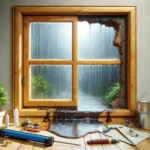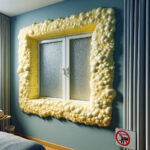You are currently co-owner or manager of a commercial building (condominiums and multi-housing) whose envelope is composed of pre-stressed concrete panels (“precast”) and you are victims of water infiltration.
Damage accumulates and generates more claims from insurers that eventually increase the cost of deductibles.
You obviously think that the caulking around openings such as doors and windows is to be redone as soon as possible. But there are also horizontal and vertical external control joints (expansion joints) between the concrete panels, which may have been affected by the weather and the various movements of the building envelope over the years.
A foundation repair specialist has accompanied you in your process, there is no way out…
Following a call for tenders, you entrust the caulking of doors, windows and control joints to a specialized contractor.
Does the situation seem to have been corrected? Not quite!
After a while, new episodes of water infiltration occur and you now doubt the quality of the caulking work that has been done by a competent, responsible and recognized contractor.
You urge the latter to carry out an inspection and verification of the work done in order to detect any failures, oversights or deficiencies. The inspection confirms that the new sealant is in perfect condition and that there are no deficiencies.
The components of the doors and windows as well as the waterproofing of the contours of the thermos panes have been checked and do not suggest any potential source of infiltration. Mystery!
Statistics to support, it is very rare, in a very short time (less than 10 years), that the new caulking is a source of water infiltration. It should be understood that caulking involves replacing a defective sealant with a new, high-quality sealant; no more, no less. If infiltration persists, it is because there is certainly another source of infiltration.
Despite all the techniques used to make a building watertight, moisture still escapes and, depending on temperature variations, it can condense behind the pre-stressed concrete panels. By liquefying, this condensation must be evacuated outwards and should not be trapped behind the walls. If the waterproofing between the walls is deficient and does not drain the water outwards, there will obviously be water infiltration inside. Unfortunately, it is following the repair of the exterior caulking that will very often show that the infiltration problems persist and are certainly caused by deficient or non-existent joints at the INTERIOR of the walls. In such cases, the caulker can’t help it and the situation requires more professional expertise in order to resolve this construction defect.
It is therefore now necessary to ensure that the spaces between the pre-stressed concrete panels contain 2 JOINTS (“two-stage joint”); 1 outer seal and 1 inner seal. The inner seal (not visible) must be 100% waterproof. On the other hand, the outer seal must have openings that will act as drains that will carry the water outwards. Depending on the age of the building, the inner seal may be deficient, downright non-existent or simply poorly designed.
Buildings with pre-stressed concrete panels and water infiltration must therefore pay particular attention to the control joints and ensure that the seal is adequate and compliant in order to correct any potentially problematic situation. Situations may vary from building to building depending on the age of the structure and the techniques used at the time of construction.
Shawn Dupuis, President
Elite Cauldration Inc.
514-910-3548



